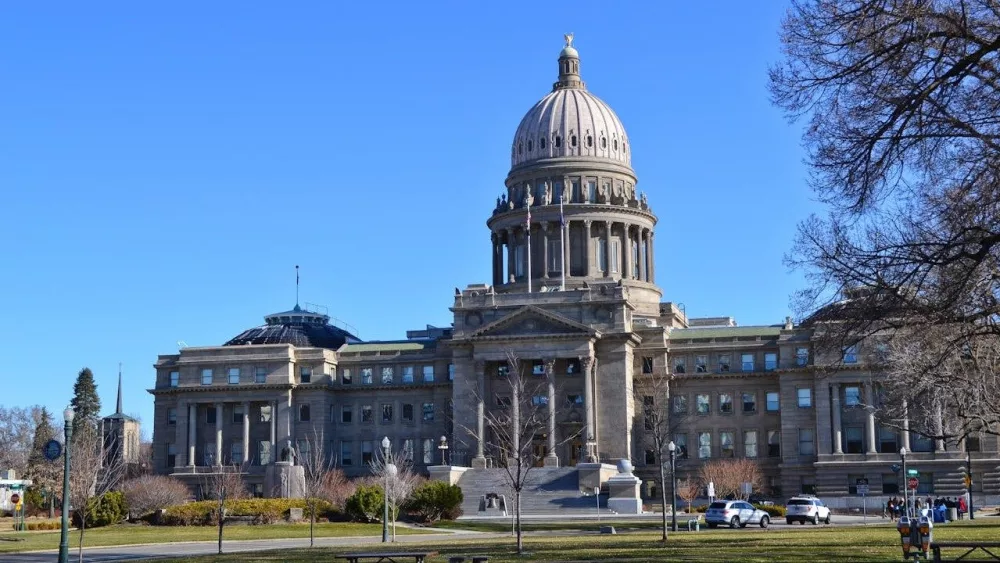Originally posted on IdahoEdNews.org on October 15, 2025
BOISE, ID – This year, the state will spend $10.6 million helping Idaho students attend medical school.
Despite these tuition subsidies, Idaho ranks last in the nation for physicians per capita — a chronic public health malaise with no quick or simple cure.
It could take years and millions of additional dollars to put more Idahoans through medical school, and get more doctors to practice in the Gem State.
Three medical schools want a piece of the action. They’re willing to take on Idaho students, if the state is willing to buy more medical school seats. A University of Washington-led medical program hopes to build on its 53-year Idaho partnership — after legislators looked at severing ties with the school this year. The University of Utah, another longtime Idaho partner, is in growth mode. The fast-growing Idaho College of Osteopathic Medicine — headquartered in Meridian and aligned with Idaho State University — has never received subsidies for their in-state students.
No one school appears able to do the job solo. Idaho might need to take an all-of-the-above approach to developing the next generation of doctors.
What do Idaho’s medical school suitors have to offer? What sets them apart? And how many more students can they take on? Idaho EdNews went to the medical schools for the answers.
How we got here
The 2025 Legislature passed a bill that could expand Idaho’s medical education network. House Bill 368 calls for subsidizing 10 new medical school seats per year, for three years. This would translate to 80 state-supported medical students, up from the current 50.
There’s a catch. None of these 30 new seats would be with the University of Washington’s medical school, which has taken Idaho students since 1972 and takes 40 Idaho students per year. The bill’s sponsors want Idaho to branch out beyond the University of Washington’s medical school program — known as WWAMI, for the member states of Washington, Wyoming, Idaho, Montana and Alaska. HB 368 says Idaho may — or may not — cut some of its seats with the WWAMI program.
HB 368 created a task force to study the medical education issue and make recommendations to the 2026 Legislature. It holds its next meeting Monday. Its report is due Jan. 2.
WWAMI: Idaho’s old-school medical school
By necessity and under duress, WWAMI’s leadership leaned into a time-honored maxim: Never let a good crisis go to waste.
For WWAMI, a five-state medical education partnership, the crisis was existential. Idaho’s most powerful lawmaker, House Speaker Mike Moyle, was pushing a bill to end the state’s 53-year affiliation with the program. As allies and alums came to the Statehouse to rally support, administrators set out to rescue the program by finding doctors willing to train WWAMI students.
The lobbying resonated, and WWAMI survived the legislative session. Meanwhile, the recruiting drive worked. Now, WWAMI administrators say they could take on 45 state-subsidized Idaho students per year, an incremental increase from its current 40-student commitment. WWAMI will take this proposal to a State Board of Education task force next week.
WWAMI at a glance
Location: Headquartered in Seattle. Idaho WWAMI students spend their first two years in Moscow, at the University of Idaho.
Relationship with Idaho: The state began subsidizing medical school seats at WWAMI in 1972, starting at 10 students per year. Since 2016, Idaho has subsidized 40 seats per year.
Student profile: About 900 Idaho students are WWAMI alums. About 50% of Idaho’s WWAMI graduates return to the state to practice medicine. Adding in graduates from WWAMI’s other member states, doctors who also choose to practice in Idaho, the state gets about a 70% placement rate from its investment, says Suzanne Allen, a vice dean with the University of Washington’s medical school.
WWAMI’s regional footprint: The UW-led program covers five states: Washington, Wyoming, Alaska, Montana and Idaho. The Seattle and Spokane, Wash., areas account for 100 students and 60 students, respectively. Alaska and Montana each subsidize 30 seats a year. Wyoming pays for 20 seats annually.
Tuition: Idaho WWAMI students paid, on average, $48,000 in 2024-25.
Rankings: The UW medical school received some high marks in the U.S. News and World Report 2025 rankings. UW tied for No. 24 nationally in occupational therapy; No. 30 for producing graduates who work in health profession shortage areas; No. 18 for the number of graduates working in primary care; and No. 26 for the number of graduates practicing in rural areas.
The rollercoaster — Moyle’s bill to kill WWAMI, and now the expansion plan — highlights a choke point in the medical education field. It’s one thing for a state to subsidize medical school seats for their students, as Idaho has since 1972. It’s another thing, and another challenge, to find partners in the field. Hospitals and medical offices willing to give medical students clinical training, and doctors willing to work as “preceptors,” mentoring students for no pay or token compensation.
WWAMI has wrestled the issue for years. The 2022 Legislature passed a nonbinding resolution, sponsored by Moyle, that encouraged WWAMI to increase its Idaho cohort to 50 students per year. Much to the dismay of Moyle and other legislators, that hasn’t happened.
“When we made that commitment to go to 50, it also happened to be right smack dab in the middle of a pandemic, where all of a sudden, through factors that no one could control, you started losing health care workers,” said Ian Goodhew, the head of government and external relations for the University of Washington School of Medicine, which oversees WWAMI.
This year’s WWAMI wildfire also was steeped in ideology. UW had never signed a document asserting that no Idaho tax dollars went to abortion training, as required under 2021 state law, prompting Moyle to accuse the university of playing politics. Goodhew says UW had always followed Idaho law, but should have put it in writing sooner.
WWAMI got something of a reprieve from the 2025 Legislature. The rewritten law that passed, House Bill 368, stops far short of killing Idaho’s partnership in the program, and doesn’t even automatically cut any of Idaho’s 40 seats. And this has given administrators one more year to tout their program’s attributes.
One is its network of Idaho clinical sites and preceptors, stretching from Sandpoint and Coeur d’Alene to Blackfoot and Idaho Falls. It’s a network 50 years in the making. “We work really hard to make sure we have enough clinical training in the state for students to stay in Idaho to do their training,” said Suzanne Allen, a Boise family physician and the UW’s medical school’s vice dean for academic, rural and regional affairs.
WWAMI also touts its rural reach — as suggested by its acronym, short for the member states of Washington, Wyoming, Alaska, Montana and Idaho. WWAMI students can get experience at Seattle’s Harborview Medical Center, and rural hospitals across the region. “WWAMI is the most geographically diverse medical education you can get in the country,” Goodhew said.
While HB 368 doesn’t cut any of Idaho’s WWAMI seats — and doesn’t rule out WWAMI’s proposed expansion — it does call for the state to subsidize seats at other medical schools. This doesn’t pose a threat to WWAMI, Allen and Goodhew say, since their program can’t meet Idaho’s needs alone.
And after the tempestuous 2025 legislative session, Allen is hoping WWAMI has weathered its existential crisis.
“If the goal is, how do we expand the physician workforce in Idaho, decreasing the number of medical students we have doesn’t make a lot of sense,” Allen said. “Not that the Legislature always does things that make a lot of sense, just to be fair. So, you know, we hope that what they do makes sense.”
Utah: Another longstanding partnership
The University of Utah’s Spencer Fox Eccles School of Medicine says it is open to taking more Idaho students. But unlike WWAMI, Utah isn’t throwing out a number or making a firm commitment.
“We are open to conversations with states, organizations, and other partners —including Idaho — about how we might expand opportunities for medical education,” the university said in response to written questions from Idaho EdNews.
University officials declined an interview request. But in their previous public statements — and in their written responses — Utah officials have said their medical school is growing. And that means they could grow a partnership that, like WWAMI, dates back to the 1970s.
Utah officials say they have no shortage of applicants. Each year, 130 to 170 students apply for Idaho’s 10 state-subsidized medical school seats. “We have far more qualified applicants than we do positions,” Benjamin Chan, the medical school’s associate dean of admissions and Idaho affairs, told a State Board of Education task force in August.
University of Utah at a glance
Location: Salt Lake City.
Relationship with Idaho: The state began subsidizing medical school seats at Utah in the 1970s. Idaho now pays for 10 seats per year.
Student profile: Since the 1970s, about 300 Idaho students have received state subsidies to attend Utah’s medical school. University officials say they don’t have a precise placement rate. But they say more than 600 Utah graduates practice medicine in Idaho, “representing a strong return on investment for the state.”
Utah’s regional footprint: Utah also reserves three state-subsidized seats apiece for Montana and Wyoming students. “This complements our Idaho partnership and reflects our role as a regional medical education hub.”
Tuition: Idaho students who receive state subsidies pay about $49,000 per year.
Rankings: In 2025, U.S. News and World Report listed the University of Utah as a Tier 2 research medical school and Tier 2 in primary care. The magazine ranked Utah No. 37 in occupational therapy; No. 59 for graduates working in health profession shortage areas; No. 84 for graduates in primary care; and No. 40 for graduates practicing in rural areas.
Space isn’t an issue either. The medical school broke ground in 2022 on a $185 million, 185,000-square-foot medical education building, which could accommodate 160 new students per year. Utah’s current capacity is 125 new students per year.
With an eye to the rural physicians’ shortage — a problem hardly unique to Idaho — Utah is branching out beyond its burgeoning main campus. The medical school plans a 10-student satellite campus in St. George, in the state’s remote redrock southwest corner.
There’s only one thing standing in the way of growing Utah’s Idaho partnership: clinical sites and partnerships. Like WWAMI, Utah is looking at calling in the cavalry.
“Clinical placements in Idaho could be a limiting factor,” the university said in its written response, “though our alumni network is strong and eager to support expansion (we currently have over 600 alumni practicing medicine in Idaho).”
Idaho State University administers the state’s longstanding Utah partnership. But Utah also figures in an expansion plan that is already getting some Statehouse pushback.
The University of Idaho, which already partners with WWAMI, has floated an $8.5 million plan to convert 8,200 square feet at its Idaho Water Center in downtown Boise into space for Utah medical education. Caught off guard, the co-chair of the Joint Finance-Appropriations Committee said a 2025 state law only calls for paying for more medical school seats.
“It does not call for a second medical school in the Treasure Valley,” said Wendy Horman, R-Idaho Falls.
In their written comments, Utah officials said they have questions too.
“We are aware of the University of Idaho’s proposal,” they said. “We would welcome more details about the proposal and evaluate it collaboratively to ensure it aligns with accreditation requirements.”
Utah says it has several unique strengths to offer Idaho. And some are a function of location.
As the Intermountain West’s only academic medical center that provides highly specialized and advanced care, Utah draws patients from a seven-state region that includes Idaho. And its Idaho partnerships go beyond medical school; since 2020, Utah and Idaho State have partnered on a residency program in rural psychiatry.
“Geographically and culturally, our proximity fosters natural connections with Idaho,” Utah officials said.
ICOM: The in-state upstart
Tracy Farnsworth remembers the skepticism that swirled around the Idaho College of Osteopathic Medicine when it was founded in 2016. They were fair questions. Would Idaho’s first medical school attract quality students and faculty to its Meridian campus? Would the fledgling for-profit private school get accredited? Would it make it at all?
“Ten years ago, this college was an idea,” Farnsworth said during a recent interview at the ICOM’s Meridian headquarters, an airy, showroom-new building overlooking Interstate 84. “It was a very risky idea.”
Farnsworth now touts ICOM as not an idea but an investment.
Accredited in 2022, ICOM has the go-ahead to build its first-year class size from 150 to 220. ICOM has ample clinical partners to accommodate any Idaho student who wants to train in-state. ICOM boasts a 100% placement rate; every graduate from four graduating classes has landed in an accredited residency program. Now is the time, he says, for Idaho to put some of its medical education money into ICOM.
Typical of many private schools, ICOM recruits from a national student pool. This year’s first-year class came from 119 universities in 31 states. The flipside is that ICOM has always drawn just a fraction of its students from Idaho. This year, only 37 first-year students came from the state, ICOM chief academic officer Kevin Wilson told the medical education task force in August.
It isn’t for a lack of interest; ICOM officials say they want to take on more Idaho students. But because of Idaho’s partnerships with WWAMI and Utah, Farnsworth said, in-state students can get a better deal going someplace else.
ICOM at a glance
Location: Meridian.
Relationship with Idaho: The state subsidizes no medical school seats at the Idaho College of Osteopathic Medicine. The for-profit private college, founded in 2016, operates in partnership with Idaho State University.
Student profile: Since its founding, 588 students have graduated from ICOM; only 96 came from Idaho. This year, California is the largest “feeder state” for first-year ICOM students; Brigham Young University is ICOM’s largest undergraduate “feeder school.”
Tuition: $67,490.
Rankings: U.S. News and World Report’s 2025 rankings for ICOM are limited. The magazine issued only one ranking, placing ICOM No. 151 in the nation for instruction in occupational therapy. ICOM questioned this ranking Wednesday, saying it does not offer instruction or programming in occupational therapy.
ICOM is in “growth mode,” Farnsworth said, and could essentially take on as many students as the state is willing to fund.
He said ICOM could easily double its in-state enrollment, utilizing its existing in-state clinical partnerships. ICOM would reserve its in-state clinical rotations for Idaho students and send out-of-state students to clinical sites outside Idaho. And he said ICOM would no have no trouble expanding its out-of-state clinical network to handle that demand.
But Farnsworth also said that it’s “only fair” that ICOM’s current in-state students would have a chance to compete for any publicly funded aid. That would mean the state subsidies might go to students already in medical school — and wouldn’t necessarily bring more Idaho students into the pipeline.
In addition to being a new school, and a private college, ICOM differs from WWAMI and Utah in another key aspect. ICOM issues a doctor of osteopathic degree, often called a DO. As allopathic medical schools, WWAMI and Utah issues the more common doctor of medicine degree, or MD for short.
About three-fourths of medical schools offer MDs, Farnsworth downplays the differences between the two disciplines. Farnsworth believes the DO approach is gaining acceptance in the medical community, and as a former hospital administrator, he said he never hesitated to hire a graduate from an osteopathic program. “They are one and the same to me.”
Farnsworth says ICOM’s Gem State presence — and its affiliation with Idaho State University — offers something distinctive to the Legislature. Located next to Idaho State’s Meridian campus, ICOM has partnered from the beginning with the state’s preeminent health care university. Idaho State officials, including current President Robert Wagner, have served on ICOM’s board of trustees. The two schools share faculty and collaborate on research, and students can seek concurrent degrees from ICOM and Idaho State.
Meanwhile, Idaho State has looked at a possible ICOM acquisition for more than a year, and is paying a national consultant $100,000 to look at the possibility. Farnsworth declined to answer specific questions about a sale — or ICOM’s potential suitors. But he said he expects the college’s owners to sell at some point, and he understands why Idaho State officials and some state leaders are looking at the idea.
“Speaking for me, do I think it would be a good thing for Idaho to acquire a school of medicine?” he said. “I do.”
Ownership questions aside, Farnsworth believes ICOM can contribute to an “all-hands-on-deck” response to the physician shortage. Idaho needs WWAMI and Utah, he said, but it needs ICOM as well. Citizen legislators have to learn the complexities of so many industries and issues, but the need to invest in medical education is clear.
“I hate to say it’s a no-brainer, but to me, it’s something that just makes so much sense,” Farnsworth said.





